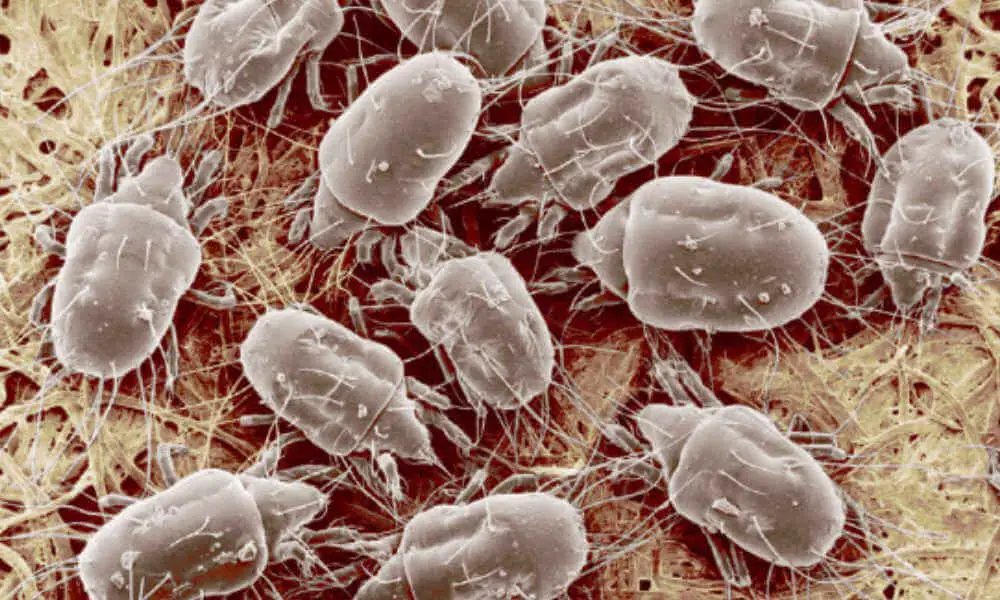Mold mites are microscopic arachnids that feed on mold and fungi. They are too small to be seen with the naked eye. A microscope with at least 40x magnification is required to get a good look at these tiny creatures. Despite their minuscule size, mold mites can cause big problems when they invade homes, workplaces, and other human environments.
Page Contents
What is a mold mite?
Mold mites belong to the arachnid family and are closely related to spiders and ticks. There are over 100 known species of mold mites. The most common varieties that infest buildings are species in the Tyrophagus genus.
These tiny arachnids feed primarily on mold, which is why they tend to thrive in damp, humid environments. They will also eat fungi, algae, pollen, and decaying plant material. Mold mites do not bite or transmit diseases to humans or pets. However, their presence indicates excess moisture that can lead to mold growth, which poses health risks.
Appearance and size
An adult mold mite measures between 0.2-0.4 mm in length. That is about the thickness of a quarter. They have a rounded, oval-shaped body that is semi-transparent white in color. Unlike spiders, mold mites have four pairs of legs as nymphs but only three pairs as adults.
Mold mites go through six developmental stages:
- Egg
- Larva
- Protonymph
- Deutonymph
- Tritonymph
- Adult
Their entire life cycle takes about 3-4 weeks depending on environmental conditions. Mold mites can survive for 2-3 months and produce 100-300 eggs each in their lifetime.
Identifying features
It’s impossible to identify mold mites with the naked eye. But under a microscope, some distinguishing features become apparent:
- Body shape – Oval and rounded, with a tougher dorsal exterior than belly
- Color – Translucent white or cream
- Legs – 3 pairs of legs as adults, 4 pairs as nymphs. Legs are short and stubby.
- Mouthparts – Chelicerae (fang-like appendages) for grasping food
- Setae – Hair-like bristles covering body
- Size – 0.2-0.4 mm in length
Behaviors
Mold mites exhibit some key behaviors that can help identify an infestation:
- They avoid light and are most active at night
- They congregate in colonies that may number in the hundreds of thousands
- They leave fecal pellets that appear as small black specks
- They spin protective webbing that gives surfaces a dusty appearance
- They gravitate toward moisture and humidity
Difference from dust mites
Mold mites are often confused with dust mites since both are microscopic and can infest homes. However, there are some key differences:
| Mold Mites | Dust Mites |
|---|---|
| Feeds on mold and fungi | Feeds on dead human skin cells |
| Prefers damp environments | Thrives in warm, humid environments |
| Does not bite humans | May bite humans and cause allergic reactions |
| Has 3 pairs of legs as adult | Has 4 pairs of legs |
| Soft, oval body | Harder, less rounded body |
Habitat
Mold mites thrive in damp, humid environments with ample mold growth. This makes poorly ventilated areas of homes susceptible to infestations. Other common habitats include:
- Bathrooms and basements
- Behind walls and under floors
- Crawl spaces, attics
- Carpet backing, upholstered furniture
- Mattresses, bedding, curtains
- Air conditioning units
- Rotting leaves, logs, and compost
- Barns, greenhouses
Signs of an infestation
Detecting mold mites can be tricky given their microscopic size. But there are some telltale signs that your home or workplace may be infested:
- Dusty coating or webbing on surfaces
- Black pepper-like specks (fecal pellets)
- Visibility near vents and fans
- Moldy odor
- Increased humidity and condensation issues
- Discovery of mold growth
- Allergy symptoms worsening indoors
Health risks
Mold mites do not directly harm human health. However, their presence signals excess moisture ideal for mold growth. Exposure to high levels of mold can cause:
- Allergy symptoms – runny nose, watery eyes, coughing, sneezing, difficulty breathing
- Asthma attacks
- Respiratory infections
- Skin irritation
- Nasal and sinus congestion
People with asthma, allergies, or compromised immune systems are most at risk. Mold can even produce toxins called mycotoxins that have more serious effects when inhaled or ingested.
Getting rid of mold mites
The key is to address excess moisture that allows mold mites to thrive. Tips for controlling an infestation include:
- Fix plumbing leaks
- Improve ventilation
- Use dehumidifiers
- Clean up existing mold with bleach solution
- Replace moldy carpets, drywall, etc.
- Discard infested clutter and fabrics
- Vacuum and dust frequently
- Use HEPA air filters
- Apply desiccant dusts
In more severe cases, fumigation by a professional pest control company may be required. Prevent future infestations by keeping relative humidity below 50% and promptly fixing any moisture issues.
Conclusion
Mold mites are tiny arachnids drawn to damp environments conducive to mold growth. They are white, oval-shaped, and reach 0.2-0.4 mm in length. Mold mites cannot be seen without a microscope magnifying at least 40x. Signs of an infestation include a dusty coating on surfaces, visible specks, worsened allergy symptoms, and discovery of actual mold growth. While not directly harmful, mold mites indicate excess moisture that allows hazardous mold to grow. Get rid of mold mites by fixing plumbing, improving ventilation, controlling humidity, eliminating mold, and keeping surfaces clean and dry.
